倉庫運用のベストプラクティス:倉庫管理、組織、運用を改善するための55の優れたヒントと戦術
倉庫管理者は、倉庫施設の運用を管理するタスクが単純ではないことをよく知っています。倉庫の運用管理者は、施設に出入りする製品の効率的な流れを確保し、建物のレイアウトを最適化し、注文が処理され、製品の在庫があり、過剰に在庫がないことを確認する必要があります。収益性を確保し、間接費と人件費を最小限に抑えることで、倉庫のオペレーターは作業を削減できます。
バランスを取るための要素が非常に多く、すべての決定を検討する際の考慮事項と、あらゆる側面の利害関係者からの圧力があります。生産性を高め、コストを最小限に抑え、スムーズなサプライチェーンフローを維持するために、倉庫業務のベストプラクティスを概説する記事やリソースがたくさんあるのは当然のことです。
倉庫業務のベストプラクティスに関する膨大な情報を分析するには、さまざまなソースからのベストプラクティスの比較的簡潔なリストをまとめました。ウェブの隅々まで精査し、倉庫業務に関するこれらの51のベストプラクティスを特定して、その分野でトップパフォーマーを目指し、企業に可能な限り最高の結果をもたらすことを目指す倉庫管理者に役立つリソースを提供しました。トピックごとに分類されていますが、以下のベストプラクティスは、特定の重要度の順序で評価またはランク付けされていないことに注意してください。特定のセクションにジャンプするには、以下の目次のリンクを使用してください。
55の倉庫運用のベストプラクティス
目次:
- 倉庫業務の資産追跡のベストプラクティス
- 倉庫運用ロジスティクスのベストプラクティス
- 倉庫業務における安全性とリスク管理
- 倉庫運用ワークフローの最適化
- 在庫管理を改善するためのベストプラクティス
倉庫業務の資産追跡のベストプラクティス
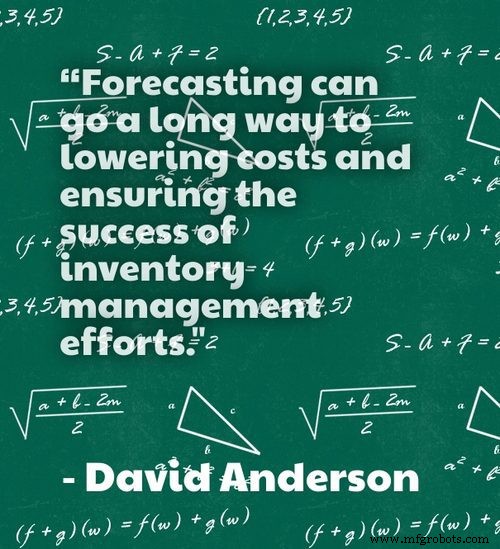
1。自動データ収集を使用します。 「紙のパッドに数字を書いたり、数字の文字列をキーボードに入力したりするのは悪い兆候です」とMcKnight氏は言います。
バーコードと無線周波数識別による自動データ収集の利点は十分に確立されています。生産性と精度の向上、人件費の削減などが含まれます。しかし、多くの企業はまだ自動データ収集を実装していません。
「30,000または40,000のアイテム番号と複数の施設を持つ一部の組織は、テクノロジーがない方が良いと確信しています」とMcKnight氏は言います。 –ノースカロライナ州ローリーに本社を置くサプライチェーン統合会社であるTompkins AssociatesInc.のパートナーであるDennyMcKnightは、LeslieHansenHarpsが今日の流通センターのベストプラクティスで引用しています。 、InboundLogistics.com
2。手動のデータ入力プロセスに依存しないでください。 「INSTEAD:受信ドックでバーコードスキャナーまたはRFIDリーダーを備えたモバイルコンピューターを使用して、到着時に製品を即座に識別します。これにより、製品をドックからすばやく降ろすことができ、識別、カウント、データ入力エラーなど、手動受信に関連するほぼすべてのエラーが排除されます。スキャンとRFIDテクノロジーを使用すると、在庫の正確性に大きな打撃を与えるミスを回避し、修正に時間とリソースを浪費します。つまり、倉庫スタッフは顧客の注文をより迅速に処理することに集中できます。」 –失われる倉庫戦略のトップ10とその回避方法 、モトローラソリューションズ; Twitter:@MotoSolutions
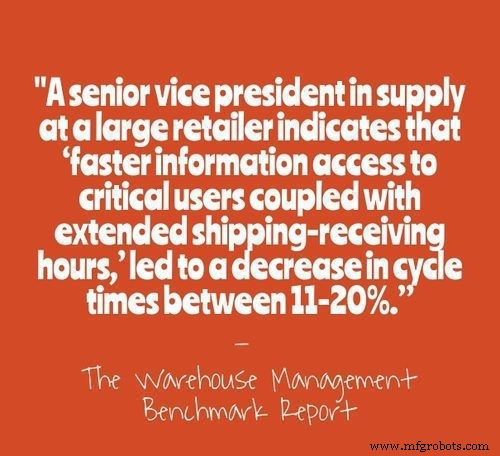
3。全社的に情報の可視性を促進します。 「クラス最高は、業務全体および会社全体で情報を共有できるようにする、広範囲に普及している倉庫の可視性インフラストラクチャを示しています。別の回答者は、改善の手段として可視性を指摘しています。大規模小売店の供給担当上級副社長は、「重要なユーザーへの情報アクセスの高速化と、出荷と受け取りの時間の延長」により、サイクルタイムが11〜20%短縮されたと述べています。」 –倉庫管理ベンチマークレポート 、アバディーングループ; Twitter:@aberdeengroup
4。倉庫管理システム(WMS)と組み合わせた資産追跡は、倉庫の生産性を最大化するために必要な自動化を提供します。 「スマートビジネスは、在庫、フルフィルメント、および配送コストの管理が成功に不可欠であることを理解しています。企業は、敏捷性、可視性、および労働効率を向上させることにより、倉庫業務の改善に絶えず努力しています。これには、運用または所有の総コスト(TCO)を最小限に抑えながら、配布操作内のすべてのリソースを最適に管理する高度な倉庫管理システム(WMS)と組み合わせたベストプラクティスを使用する必要があります。」 – 倉庫とフルフィルメント:フルフィルメントプロセスを合理化し、顧客の満足度を維持します 、NetSuite; Twitter:@NetSuite
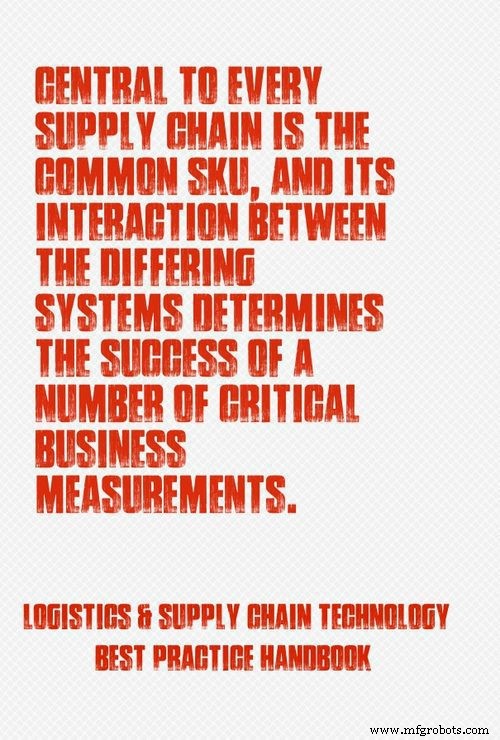
5。データ同期により、可視性が向上し、通常は労力を要するデータ統合タスクが合理化されます。 「すべてのサプライチェーンの中心は共通のSKUであり、異なるシステム間の相互作用が、多くの重要なビジネス測定の成功を決定します。あらゆる規模の組織のソフトウェアアプリケーションの複雑なスイート間でデータフローを調和させるための鍵は、企業内で共通のSKUに関連するすべてのデータを水平または垂直に同期することです。システムレベルで一般的な製品データを標準化し、データ変換の障壁がないこのアプローチは、労働集約的なデータ統合タスクに急速に取って代わります。組織間のデータ取引における次の進化段階は、データリポジトリがサプライヤから直接提供された最新のSKU情報で更新されることです。この相互運用可能なデータの転送は、現在、グローバルで費用効果の高いレベルにあり、在庫リポジトリをシームレスにアップグレードし、キーの再入力を排除し、重複を減らしています。これは、SKU情報の継続性がWMS、BOS、およびPOSへの投資に不可欠であるベストプラクティスになるように設定されています。データの1つのソースは理にかなっています。その結果、小売業者、サプライヤー、消費者がすべて勝者になります。ほとんどの企業は返品と再配達の排除を目指しています。サプライチェーンの罰金またはチャージバックを削減します。より良い請求書の照合と在庫保持を提供するために、いつかカーボンフットプリントではなくカーボンフィンガープリントについて話し合うかもしれません。」 –ロジスティクスおよびサプライチェーンテクノロジーのベストプラクティスハンドブック 、BASDA; Twitter:@BASDAUK
6。ビンの場所を使用して、製品をすばやく見つけます。 「ビンの場所を使用して製品を見つけていますか?現在入手可能な配布ソフトウェアパッケージの大部分は、ビンの場所を利用しています。これにより、ショールームおよび倉庫ゾーン内の製品を即座に正確に配置できます。多くのディストリビューターは、ベンダーラインをまとめる必要性が認識されているため、このツールを利用することに躊躇しています。実際、ビンの場所では、販売量に基づいて製品を自由に見つけることができるため、注文の大部分に表示される傾向のある重要なアイテムを選ぶために必要な足跡の数を減らすことができます。私はこれを速度ランクで製品を見つけることと呼んでいます。
「「温度テスト」に合格できますか?新入社員または臨時従業員を連れてきて、この個人が2〜3時間以内に生産的であると確信できますか?ビンの場所を利用すると、新入社員がフォローするためのマップが提供されます。これにより、マテリアルハンドリングの分野で熟練した人を探すことができます。ビンの場所がない場合、注文を満たす製品を見つけるために、あなたが運ぶ製品ライン内で経験を積んだ誰かを探す必要があります。これらのさまざまな製品ラインが4つの壁のどこに保持されているかを知るには、より多くの手を握る必要があります。」 – Dan Belanger、効率的な(そして安全な)倉庫業務のすべきこととすべきでないこと 、ガスおよび溶接販売業者協会(GAWDA); Twitter:@GasWeldEdge
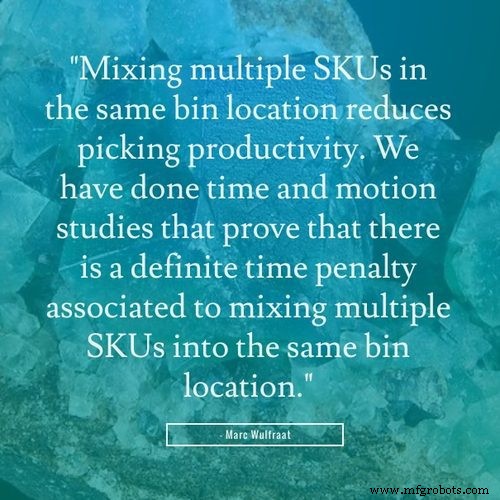
7。 1つのビンの場所に複数のSKUを混在させないでください。 「同じビンの場所で複数のSKUを混合すると、ピッキングの生産性が低下します。複数のSKUを同じビンの場所に混合することに関連する明確な時間ペナルティがあることを証明する時間と動きの調査を行いました。
「これは、ビンの場所が5を含む棚レベルを表す可能性がある多くの倉庫で見られます。 –10SKUピックフェーシング。オペレーターは棚レベルに誘導され、さまざまなSKUを検索して、選択するアイテムを見つける必要があります。
「これにより、精度が低下するだけでなく、オペレーターの速度が15秒以上遅くなります。ピックトランザクションごと。すべてのSKUに個別のピッキング場所を設定することがルール#1です。」 –MWPVL社長MarcWulfraat、注文ピッキングの生産性を向上させる5つの方法 、SupplyChain247; Twitter:@ SupplyChain247
8。資産追跡システムを使用して、特定の時間枠内に在庫が選択された回数を記録します。 「商品を在庫することが意味をなさない場合があります。一例として、アイテムが年に5回だけピッキングされる場合、保管のコストは、メーカーからの直送によって排除できます。製品が選択された回数を記録することで、在庫が存在するスペースの価値を判断できます。」 – ベストプラクティス–在庫管理 、プロモーションフルフィルメントセンター; Twitter:@PFCFulfillment

9。資産追跡により、より正確な予測が可能になり、コストの削減と在庫管理の改善に不可欠です。 「予測は、コストを削減し、在庫管理の取り組みを確実に成功させるのに大いに役立ちます。小売業者が必要なアイテムと正しい数量を正確に予測できる場合、余剰在庫がなくても顧客の期待に応えるのに適しています。より良い予測には、市場調査、市場需要モデル、需要パターン、最小在庫レベル、および過去の手法を巧みに観察する必要があり、在庫管理を成功させる上で大きな役割を果たすことができます。」 – David Anderson、3つの在庫管理のベストプラクティス 、SalesWarp; Twitter:@SalesWarp

10。アセットのシリアル番号ではなく、一意の追跡番号を使用してください。 「アセットのシリアル番号が別のアセットのシリアル番号と同じになる可能性があります。シリアル番号を追跡番号として使用すると、2つの資産を区別する方法がないため、番号が重複すると混乱が生じます。これにより、データの整合性が損なわれ、顧客の残高と在庫が不正確になり、賃貸収入が減少し、顧客満足度に影響を与える可能性があります。シリアル番号とは異なる一意の追跡番号を使用すると、これらの問題が解消されます。まれに追跡番号が失われた場合でも、シリアル番号を使用してアセットを検索し、適切にラベルを付け直して、アセットの履歴を保持することができます。」 – Christine Span、トップ5のアセットトラッキングのベストプラクティス 、TrackAbout; Twitter:@trackabout
倉庫運用ロジスティクスのベストプラクティス
11。事前の出荷通知を確立します。 「これは簡単に思えるかもしれませんが、多くの配送センターはまだ電子的に送信された事前出荷通知(ASN)を実装していません。 「定期的な」出荷と受け取りのスケジュールに依存すると、配送センター全体で非効率になる可能性があります。遅延が発生し、混乱が発生します-そしてそれは「通常の」スケジュールからの逸脱を引き起こします。結果として生じる問題は、受け取りドックでの不適切な人員配置から始まり、倉庫全体に波及します。ただし、発注書および在庫管理機能内で電子的な事前出荷通知を活用することにより、より確実に労働を計画することができます。注文処理と輸送活動は、適切なサービス時間要件が満たされるように調整でき、輸送モードはコストを抑えるように最適化されます。」 –11サプライチェーンの倉庫および流通センターのベストプラクティス 、レガシーサプライチェーンサービス
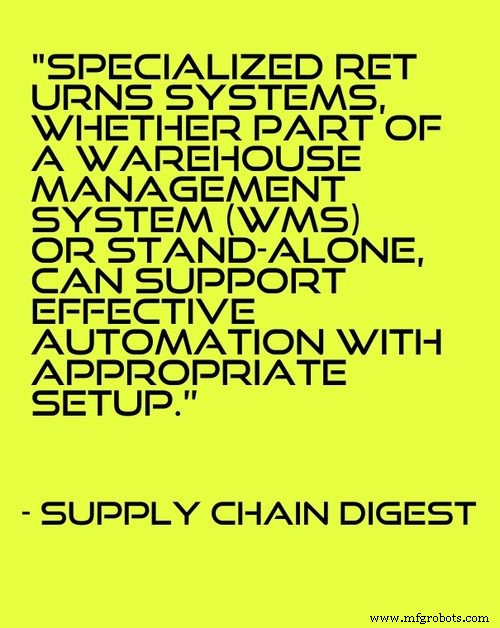
12。効率的な返品プロセスを実装します。 「返品は、実地棚卸、電子在庫、会計システムにどのように影響するかにより、根本的に複雑です。すべてのアイテムを識別し、顧客またはアカウントに割り当て、処分を割り当ててから、処理のために物理的にソートする必要があります。一部の製品は、ベンダーのチャージバックのために廃棄または保管される可能性があるため、すべての商品が電子在庫に入るわけではありません。一部の商品は、手動ではなく電子的に再梱包して会計処理する必要があります。最後に、クレジットは通常、後で発行され、多くの場合、廃棄された商品や販売できない商品を含む、返品の一部に対してのみ発行されます。このプロセスは、一般的なERPパッケージでは自動化が難しく、単純な紙のプロセスでは非常に困難です。倉庫管理システム(WMS)の一部であろうとスタンドアロンであろうと、特殊な返品システムは、適切な設定で効果的な自動化をサポートできます。」 – エキスパートインサイト:倉庫返品のベストプラクティス 、サッピーチェーンダイジェスト; Twitter:@scdigest
13。タスクを効率的に処理し、先延ばしを回避します。 「サプライヤから大量の出荷を受け取った場合、簡単に「オール」と言うことがあります。後でこれを処理しましょう。」先延ばしに終止符を打ち、時間をかけて箱を分解し、ごみ箱に入れ、製品を開梱し、それに応じて保管します。これはあなたがコミットしなければならない習慣です。貨物が毎日/週のほぼ同じ時間に到着する場合は、カレンダーでスケジュールします。それを延期すると、それはさらに大きな獣になり、あなたの注意を待っているだけです。
「棚にそれらをストックする時間がない場合、小売業で働いていたときに私が行っていたもう1つのことは私でしたすべての箱を取り、それらを並べます。それぞれを開いて、何が含まれているかを確認してください。そこから、各ボックスにミニストッキングパイルを作ります。それらが最終的にどこに収容されるかを知って、それらを倉庫の床の正しい場所に引っ張ってすぐにストックできるように、近接したアイテムをまとめます。」 – Breena Fain、倉庫管理システムを最適化する6つの方法 、StitchLabs; Twitter:@StitchLabs
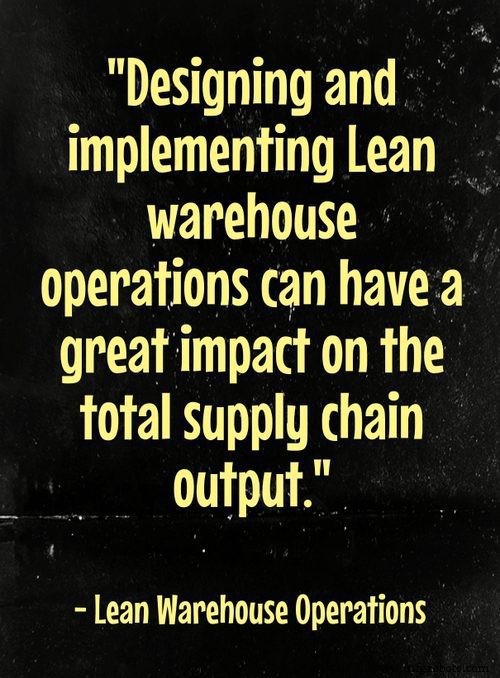
14。無駄のない倉庫運用慣行を実装します。 「無駄のない倉庫業務の設計と実装は、サプライチェーン全体の生産量に大きな影響を与える可能性があります。リーンソリューションを使用して上記の廃棄物の重点分野にアプローチすることにより、倉庫保管のリードタイムを短縮するために発生するいくつかの機会は次のとおりです。
- ピッキング、片付け、パレタイズ、出荷の際のマテリアルハンドリング時間の短縮。
- サプライチェーンの残りの部分を調整するための情報の信頼性。
- トラックとコンテナの積み降ろし時間の短縮。
- 在庫の確認と検索に費やす時間の削減。
- 変化する市場の状況や顧客の仕様に適応するための柔軟性が向上しました。」 –リーンウェアハウスオペレーション 、4つの原則
15。インバウンドとアウトバウンドの貨物を管理して、この領域のコストを削減します。 「仮想図書館は、この領域のコストを削減または減速する方法に関する記事でいっぱいになっています。それは利益の低下を防ぐためにあなたの一番の継続的な焦点でなければなりません。コンサルタントを利用して、競争力のある入札を支援してください。運送業者契約は独自のものですが、経験豊富なコンサルタントは、サービスレベルを損なうことなく削減を交渉する領域を特定するのに役立ちます。」 – カートバリー、倉庫の効率を改善してコストを削減する10の方法 、マルチチャネルマーチャント; Twitter:@mcmerchant
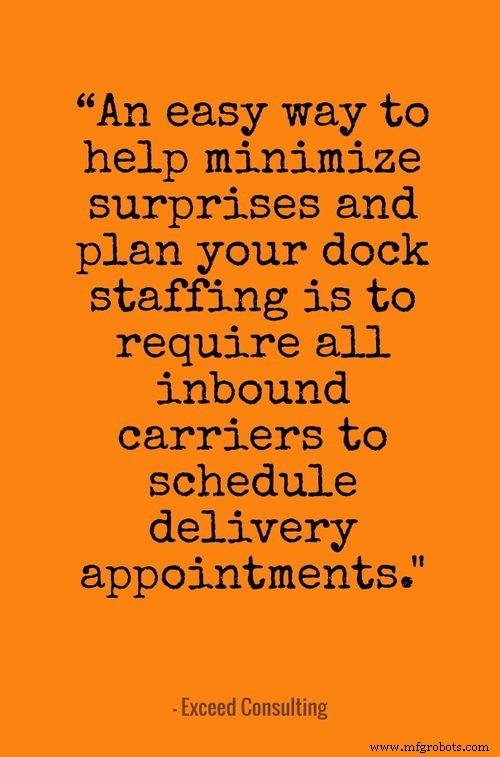
16。ベンダーが予約を受け取ることを要求します。 「驚きを最小限に抑え、ドックの人員配置を計画するのに役立つ簡単な方法は、すべてのインバウンドキャリアに配達の予約をスケジュールするように要求することです。スケジュールには2つの異なる方法があり、同時に使用できます。最初の方法は、各運送業者または配達に特定の時間または時間枠を割り当てて配達することです。 2つ目は、特定のスケジュールまたは定期的な毎日、毎週、または毎月のスケジュールを割り当てて到着することです。これにより、それに応じてスタッフをスケジュールし、ドックを最大限に活用することができます。ドックを共有したり、同じエリアからインバウンドとアウトバウンドの両方で出荷したりする場合、ベンダーが予約を受け取ることは非常に重要です。事前の事務処理またはデータは、配達が行われる前に提供する必要があります。予定と入ってくる荷物に関する情報を要求することで、驚きは最小限に抑えられます。」 – 基本に戻る、パート1:受信 、Exceed Consulting
17。 ABC分析を実施します。これは、在庫を価値別に分類するのに役立ちます。 「ABCは、最も価値のあるアイテムから最も価値の低いアイテムまでの階層です(ドル値で)。これは、在庫分類方法とも呼ばれます。在庫全体を均等に評価できない可能性があるため、このコントロールを使用すると、時間とリソースを最も収益性の高いアイテムに集中させることができます。
「A-アイテムは高額または優先在庫です。これらの商品は、収益とコストの最大の要因であるため、より厳密な管理と監視が必要です。それらのコストのために、あなたはおそらく手元に少量を運ぶでしょう。これらのアイテムは非常に人気があるため、「鍵と鍵」の下に保管する必要があります。セキュリティに加えて、Aリスト製品はより頻繁な在庫レビューと再注文を必要とします。これにより、十分な供給が確保されます。
「逆に、Cアイテムの値は低くなりますが、大量に運ぶ可能性があります。たとえば、金物店を経営している場合、大量の釘はCアイテムと見なされる場合があります。 Bアイテムは、価値、量、在庫レビューと再注文の頻度の真ん中にあります。」 – Colleen Rodericks、在庫管理の手法とベストプラクティス 、inFlow; Twitter:@inFlowInventory
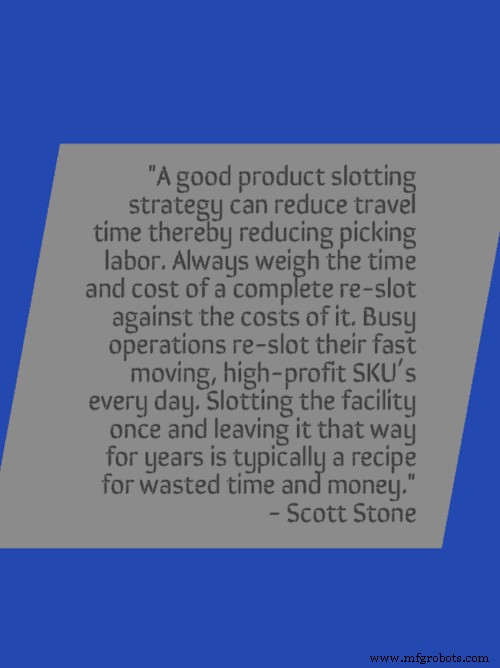
18。必要に応じて、ピック位置を再スロットします。 「ピッカーの毎日の活動の最大60%が移動時間(徒歩またはフォークリフトや歩行者)に関係している可能性があるため、その時間を短縮することは優れたアイデアです。優れた製品スロット戦略は、移動時間を短縮し、それによってピッキングの労力を削減できます。完全な再スロットの時間とコストを、そのコストと常に比較検討してください。忙しいオペレーションでは、動きの速い高収益のSKUを毎日再スロットします。施設を一度スロットに入れて何年もそのままにしておくことは、通常、時間とお金を無駄にするレシピです。」 – Scott Stone、倉庫の生産性に関する13のベストプラクティス Cisco-Eagle; Twitter:@CiscoEagle
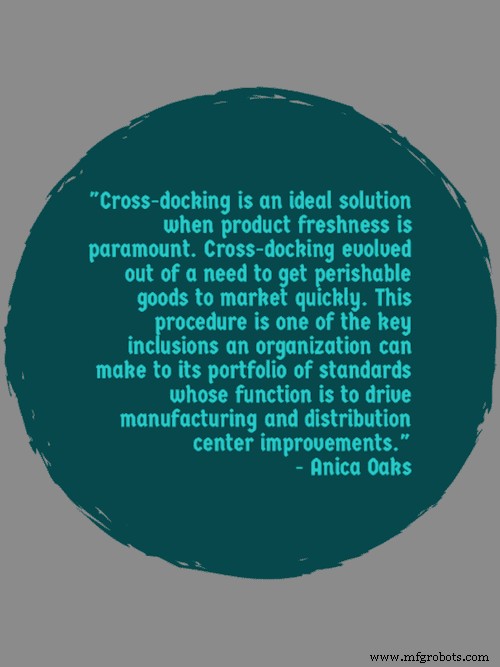
19。可能な限りクロスドッキングを利用してください。 「優れたロジスティクス計画には、可能な限りクロスドッキングが含まれます。クロスドッキングとは、入荷車両から資材を降ろし、倉庫保管間隔を最小限またはゼロにして、これらの同じ資材を出庫車両に直接積み込むことです。これを「ジャストインタイム」配送と考えてください。クロスドッキングは、製品の鮮度が最優先される場合の理想的なソリューションです。クロスドッキングは、生鮮食品を迅速に市場に出す必要性から発展しました。この手順は、組織が標準のポートフォリオに含めることができる重要な要素の1つであり、その機能は製造および流通センターの改善を推進することです。」 – Anica Oaks、倉庫の5つのリーンベストプラクティス> アプリソ製造変革ブログ; Twitter:@Apriso
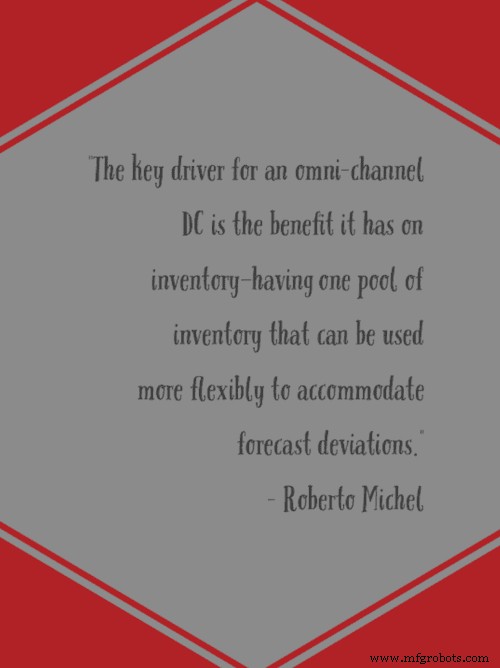
20。複数のチャネルの注文を満たすDCを作成します。 「オムニチャネルのフルフィルメント効率を求めている一部の企業では、単一のチャネル専用のDCから離れ、代わりに複数のチャネルの注文を処理するDCを使用する傾向があります」とCommonwealth SupplyChainAdvisorsの創設者兼マネージングディレクターであるIanHobkirkは述べています。 。
「'eコマースがまだかなり新しい10年前、企業がDCを設定および実行する方法で多くのチャネル分離があり、多くの場合、eコマースのフルフィルメントは3PL」とホブカークは言います。 「小売業者の間で現在見られる傾向の1つは、すべてのチャネルの在庫とフルフィルメントが同じ屋根の下にあるマルチチャネルフルフィルメントセンターを持つことです。」
「オムニチャネルDCの主な推進力は在庫に対するメリット—予測の偏差に対応するためにより柔軟に使用できる在庫のプールが1つあります。 「共通の労働力プールを使用できることによるコストの削減など、オムニチャネルフルフィルメントセンターを推進する他の要因がありますが、この傾向を真に推進しているのは在庫要因です」とホブカーク氏は言います。
「上昇オムニチャネルフルフィルメントにより、在庫管理がより複雑になり、倉庫管理システム(WMS)、エンタープライズリソースプランニング(ERP)、需要管理、クロスなど、実行、予測コラボレーション、および管理レポートのためのより優れたシステムの必要性が高まります。 -学際的なコラボレーションは、サプライチェーンアドバイザリー会社St.OngeCompanyのシニアコンサルタントであるDonDerewecki氏は言います。」 – Roberto Michel、倉庫/ DC管理:在庫管理を改善するための6つのベストプラクティス 、ロジスティクス管理; Twitter:@LogisticsMgmt
倉庫業務における安全性とリスク管理
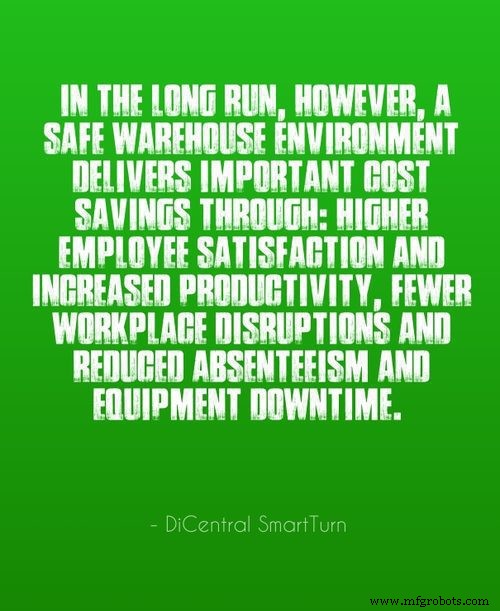
21。倉庫の安全を最優先にします。 「倉庫の安全性には、消防法やOSHA規制への準拠以上のものがあります。残念ながら、あまりにも多くの倉庫と3PLは、安全性を法律またはその良心によって義務付けられている最小要件を満たしていると見なしています。多くの場合、どちらも十分ではありません。この章では、倉庫の安全に関するベストプラクティスを見て、倉庫に安全文化を構築することと、そうしないことの両方の従業員、管理者、および雇用者にとっての利点とリスクについて説明します。安全性の促進に失敗した企業にとって、それは多くの場合、不十分な時間、不十分なリソース、またはコーナーカットによってお金を節約する機会が原因です。ただし、長期的には、安全な倉庫環境は、従業員の満足度の向上と生産性の向上、職場の混乱の減少、欠席と設備のダウンタイムの削減を通じて、重要なコスト削減を実現します。保管やマテリアルハンドリング機器などの倉庫インフラストラクチャの寿命を延ばすだけでなく、在庫への損害を減らすことができます。最も重要なことは、安全な職場に驚異的な値札が付いていると思い込まないでください。」 –在庫および倉庫管理のベストプラクティス 、DiCentral SmartTurn; Twitter:@DiCentral_EDI
22。安全委員会を結成します。 「特に深刻ではありませんが、倉庫の事故は数多くあります。米国労働統計局によると、倉庫および保管業界では毎年15,000人近くの負傷者や病気が発生しています。
「事故を防ぐために、倉庫のオペレーターは強調する必要があります。労働者のトレーニングと安全のベストプラクティスの確立について、倉庫管理とサプライチェーンにおけるその役割を専門とするイリノイ州オークブルックを拠点とする組織である倉庫教育研究評議会(WERC)のエグゼクティブディレクターであるボブショーネシーは述べています。
「ほとんどの倉庫では、安全委員会の形成は、強化された安全手順を実装するための最初のステップです。
「安全委員会のメンバーは通常、倉庫のフロアワーカー、シフトスーパーバイザー、部門マネージャーなどの特定の組織グループから選択されます。このアプローチはすべての人に発言権を与えますが、委員会の規模を有効な参加者数に保ちます。」 –ジョン・エドワーズ、倉庫の安全性:事故はありません 、インバウンドロジスティクス; Twitter:@ILMagazine
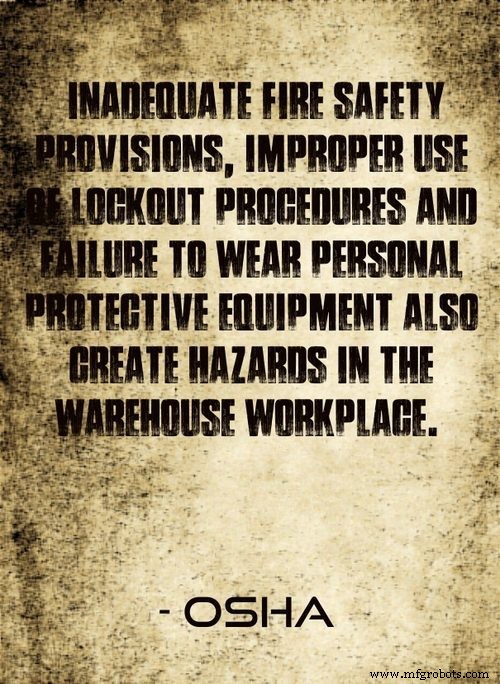
23。緊急対応計画を立ててください。 「不適切な防火対策、ロックアウト手順の不適切な使用、個人用保護具の着用の失敗も、倉庫の職場に危険をもたらします。雇用主は、緊急時に従業員に何が期待されるかを説明する緊急計画を立てる必要があります。これには次のものが含まれます。
•非常口の場所と
避難手順の規定;
•すべての従業員と訪問者の会計手順
•
•消火器および
その他の非常用機器の場所と使用。」 – OSHAポケットガイド、労働者安全シリーズ:倉庫保管 、OSHA.gov; Twitter:@usdol
24。船積みドックやステージングエリアでよくある事故を避けてください。 「積み込みドックまたはステージングエリアは、怪我や製品の損傷が発生する倉庫内の一般的なエリアです。一般的な危険は次のとおりです。
•製品が従業員の頭、足、腕、脚に落ちる;
•混雑を引き起こす弱いハウスキーピングプログラム;
•従業員が高い標高から低い標高へ;
•ドックプレートを持ち上げ、絶えず調整します。および
•ドックから転がるフォークリフトまたはパレットジャッキ。
「コントロールには次のものが含まれます:
•ドックプレートが転がらないように固定する;
•荷物と一時保管場所の毎日の検査を実施する
手配;
•決してフォークリフトまたはパレットジャッキを
ドックの端に戻すことを許可します。
•高いドックの高さから低い地面への従業員の移動に関する安全規則を施行します。
および
•割り当てられた安全検査フォームの監視ウェストベンド。 Twitter:@WBsilverlining
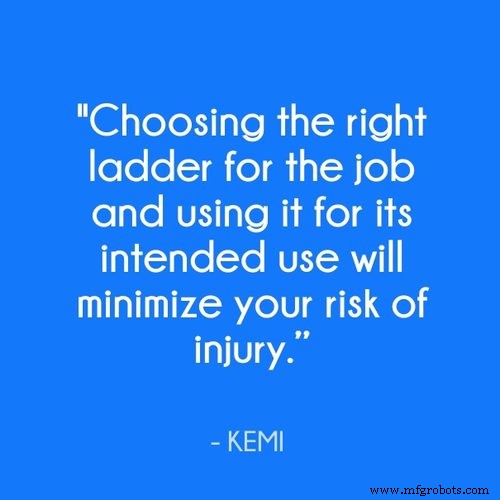
25。倉庫内のさまざまなジョブに適切なはしごを提供し、作業者がタスクに最も適切なはしごを簡単に特定できるようにトレーニングを提供します。 「倉庫内で発生する可能性のある怪我の原因は、マテリアルハンドリングだけではありません。スペースをより有効に活用するために、アイテムを積み重ねる必要がある場合があります。はしごを使用して、棚やラックの上部に到達することができます。仕事に適したはしごを選び、それを本来の用途に使用することで、怪我のリスクを最小限に抑えることができます。」 –倉庫の安全性 、KEMI
26。流出物をできるだけ早く片付け、スタッフが短時間エリアを離れる必要がある場合は、通路から在庫と備品を取り除きます。 「倉庫はたくさんのものがある場所です。その狭い通路、高い商品の山、および不十分な照明は、視界を損なう可能性のある正確な要素です。材料の滑りやつまずき、液体のこぼれは一般的な事故であり、倉庫が適切な照明を維持し、暗いコーナーに簡単にオンとオフを切り替えることができる特別なライトを装備すれば回避できます。不要な階段や尾根を取り除き、貨物、箱、商品を床に放置しないように従業員に促します。
「倉庫作業員が一時的に床を離れる必要がある場合は、資材を移動することが重要です。ライトをつけたまま通路の中央から。何かがこぼれた場合、従業員は適切な措置を講じて、目に見える標識でそのエリアを閉鎖し、できるだけ早く清掃する必要があります。」 – Tom Reddon、最も一般的な倉庫事故を回避する4つの方法 、職場での知識

27。訓練を受けたオペレーターのみが、フォークリフト、クレーン、ホイストなどの機器を使用する必要があります。 「危険を証明できる倉庫設備は、フォークリフトと台車だけではありません。コンベアの可動部品に接触すると、重傷を負う可能性があります。そのため、警備員を配置することが非常に重要です。クレーン、ホイスト、およびデリックは、荷物が人にぶつからないようにしたり、荷物が吊り下げられているときに手や足をコントロールから外したりするのに十分な知識を持った訓練を受けたオペレーターだけが操作できます。さらに、近くで働く人は誰でもクレーンの動きに注意を払う必要があります。クレーンの下で作業したり立ったりすると、問題が発生します。この機器の装填方法にも危険が見られる場合があります。重い荷物や不均衡な荷物は転倒し、致命的な怪我をする可能性があります。」 BLR.com; Twitter:@BLR_INC
28。火災のリスクを最小限に抑えるために、健全な保管方法を使用してください。 「保管方法は、同じ材料の延焼率とその重大度に影響を与える可能性があります。たとえば、垂直に保管された紙リールは、煙突効果を引き起こす可能性があります。屋内保管の場合、推奨される杭の最大高さは4.5mです。パイルの最上部から屋根部材、電気器具、または火災検知器の最下部までのクリアランスは、最低1mである必要があります。材料を積み重ねることができる最大の高さを示すために、壁にカラーバンドをペイントする必要があります。」 – N.V.SubbaRaoおよびK.RamishRamalingham、倉庫のリスク管理 、Cholarisk.com
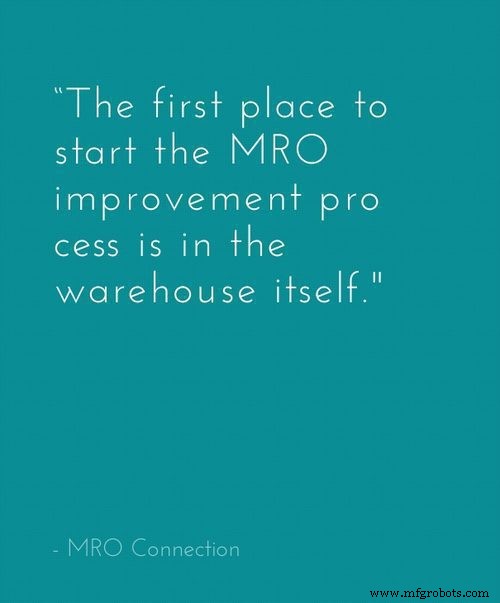
29。安全装置は常に使用する必要があります。 「倉庫では、重すぎるアイテムを持ち上げるためにフォークリフトまたは油圧ドリーを使用することが重要です。必要に応じて、適切な眼鏡とヘルメットも着用する必要があります。従業員は非常口に注意する必要があり、屋根に設置されたスプリンクラーはいつでもブロックされるべきではありません。安全装置は職場の怪我を最小限に抑えるために実装されているため、使用を開始するのに時間がかかる場合がありますが、長期的には効果があります。」 – 倉庫の安全原則:職場を安全に保つための6つの重要なガイドライン。 、AdaptALift; Twitter:@aalhyster
30。目立つ場所と重要なエリアに安全性の期待を投稿してください。 “Warehouse supervisors should ensure all safety expectations are posted clearly in close proximity to all equipment—forklifts, hydraulic dollies, hand jacks, etc. Doing so assures that employees have constant visual reminders of the inherent dangers of using such equipment, and the safety precautions they should take to avoid injury.” – Warehouse Safety Checklist:8 Things Every Manager Should Review , Legacy Supply Chain Services; Twitter:@legacyscs
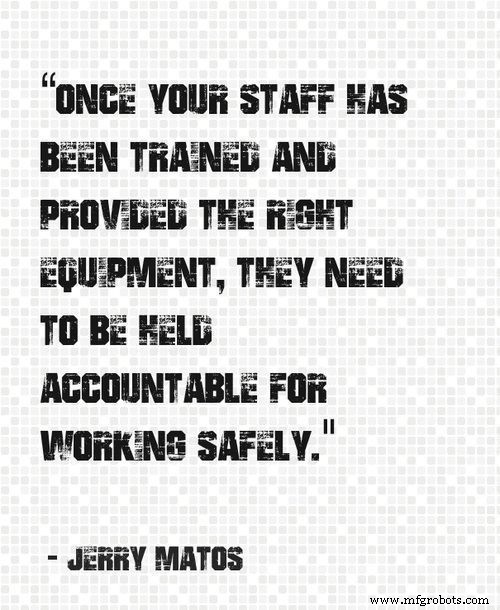
31. Establish accountability and give staff a sense of ownership over warehouse safety practices. “Once your staff has been trained and provided the right equipment, they need to be held accountable for working safely. This must apply to everyone in your warehouse. You cannot overlook bad habits of supervisors while reprimanding a dockworker. How you handle safety infractions is up to you, but your employees must own their actions. You will see better results if you offer suggestions for safer operation at the same time you express criticism.
“You do need to document lapses in safety. Without proper records, you may not have the backup you need to take action against an employee that continues to ignore your requirements. Documentation will also help protect you if an employee is injured performing an action after they have been instructed otherwise.” – Jerry Matos, Product Specialist, Cherry’s Industrial Equipment, 6 Ways To Encourage Warehouse Safety , Industrial Distribution; Twitter:@indistwebsite
32。 Consider enlisting an outside expert to identify warehouse hazards. “To help improve the safety in the workplace, consider bringing in an outsider. The outsider does not necessarily need to be a consultant or OSHA representative, but may be a business associate, or peer. The point is to have a fresh pair of eyes evaluate the warehouse. Sometimes what is seen in plain sight every day may be an overlooked hazard.” – Best Practices for Warehouse Safety , Labor Law Center
Optimizing Warehouse Operations Workflows
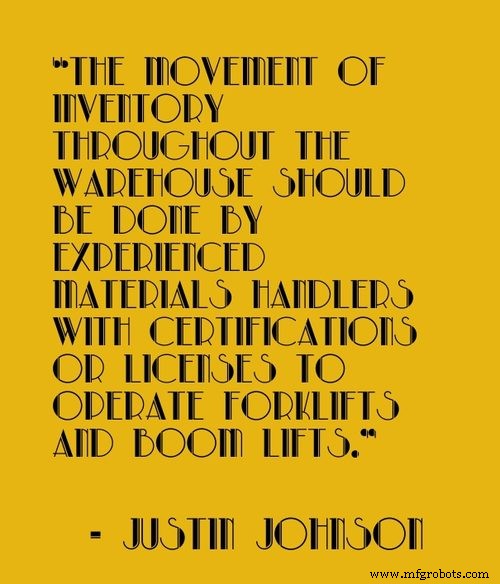
33. Clear aisles make for an efficient flow of inventory. “The movement of inventory throughout the warehouse should be done by experienced materials handlers with certifications or licenses to operate forklifts and boom lifts. These materials handlers should be able to move from one section of the warehouse to another with ease due to aisles that are not full of unstored inventory. Inventory that has not been placed in its proper bin or warehouse location can cause problems with inventory systems, especially under a FIFO, or First In, First Out, inventory system. A FIFO system ensures that the inventory that was received yesterday is moved to the shipping dock before the inventory that was received today. This inventory system reduces the chance of obsolete inventory sitting in warehouse bins.” – Justin Johnson, Best Practices in Warehouse Operations , Chron.com
34。 Store the most frequently picked items close to the shipping area. “When considering the level of effort involved in warehouse operations, the greatest expenditure of effort is in the picking process. To gain efficiencies in picking the labor time to pick orders needs to be reduced and this can achieved in a number of ways. Companies with the most efficient warehouses have the most frequently picked items closest to the shipping areas to minimize picking time. These companies achieve their competitive advantage by constantly reviewing their sales data to ensure that the items are stored close to the shipping area are still the most frequently picked.” – Martin Murray, Supply Chain/Logistics Expert, Warehouse Best Practices , About.com
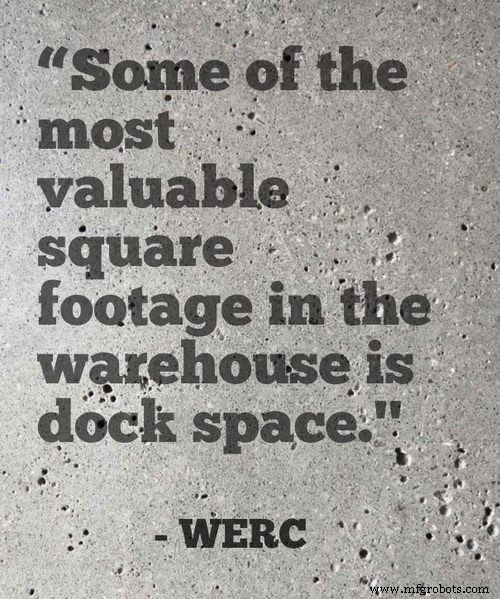
35. Implement efficient dock management practices. “Some of the most valuable square footage in the warehouse is dock space. All material must flow in and out of your docks, and these are limited in number (and not readily added to). Space on the inside and outside of the docks is some of the busiest in your warehouse. Dock best practice depends on the type of inbound you receive and for many companies balancing available dock doors, equipment, and labor is difficult, so the receiving dock becomes a choke point in the supply chain. Docks in today’s warehouses must be more flexible and must support a variety of receipts that are coming in at a faster rate and in greater frequency and with just in-time and VMI programs, smaller quantities and mixed pallets.” – Warehousing &Fulfillment Process Benchmark &Best Practice Guide , Warehouse Education and Research Council (WERC); Twitter:@WERC
36。 Calculate resource and space requirements based on expected receipts and current backloads. “Put-away is the process of moving material from the dock and transporting it to a warehouse’s storage, replenishment, or pick area. Best-practice companies manage the put-away area by calculating resource and space requirements based on expected receipts and current backlogs. Best practice is to put away product the same day it’s received, because not doing so affects space, causes congestion, increases transaction errors, and makes product more susceptible to damage. In a busy warehouse, it is easy to let product put-away fall behind other tasks such as picking, replenishment, shipping, and loading. But pulling away resources from put-away tasks can affect fill rates by not having product in pick racks. This can bring about congestion in staging areas that overflow into aisles. Delaying put-away may also result in product damage as the merchandise is moved, again and again, to make way for higher priority receipts. Proper staffing of the put-away team will support down stream processes of picking and shipping, and in the long run lead to better customer order fill rates.” – Kate Vitasek, Best Practices in Material Handling and Put-away , Multi-Channel Merchant; Twitter:@mcmerchant

37. Establish stable warehouse operations within the warehouse first, then work to improve pre-planning efforts. “The first place to start the MRO improvement process is in the warehouse itself. Once stable warehouse operations have been established, maintenance and operations can work to improve their pre-planning efforts. At first glance, this appears to be a daunting task. Trying to organize, store, identify and properly manage thousands of disparate inventory items, with different and seemingly unpredictable demand patterns, creates an environment in which it is difficult to succeed. Creating an implementation strategy that is simple, straight forward and thorough, is critical to a successful MRO Warehouse Operation.” – Creating the “Perfect Warehouse,” MRO Connection
38。 Maximize vertical space. “On the production floor, where space can be limited, it’s important to take advantage of every inch of available space (floor to ceiling). As noted in an Occupational Health &Safety article, solutions such as pallet racking can lead to safer working conditions as well as increased efficiency in the warehouse. Pallet racking, the most common way of storing pallet loads in the world, is an easy-to-use storage solution; it’s used in the vast majority of warehouses, manufacturing facilities, commercial warehouse operations, and even retail stores.” – Jennie Dannecker, 10 Ideas for More Efficient &Productive Warehouse Operations , Cerasis; Twitter:@Cerasis
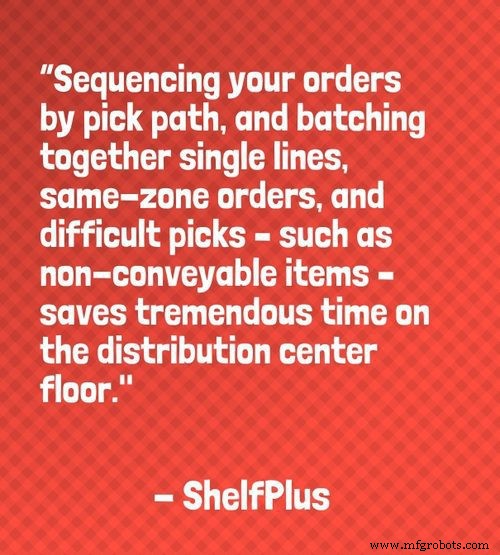
39. Use your WMS software to sequence orders and organize the workflow. “Sequencing your orders by pick path, and batching together single lines, same-zone orders, and difficult picks – such as non-conveyable items – saves tremendous time on the distribution center floor. Again, your WMS software should be able to organize the workflow and optimize sequence performance.” – 10 Ideas for a More Efficient Warehouse Operation , ShelfPlus
40。 Communicate effectively — and often. “Clearly communicating to workers your organizational goals and the processes to achieve them is one key to effective warehousing operations. When managers fail to create an environment of open and clear communication, employee productivity suffers, resulting in high turnover and wasted resources.” – Increasing Warehouse Productivity , Inbound Logistics; Twitter:@ILmagazine
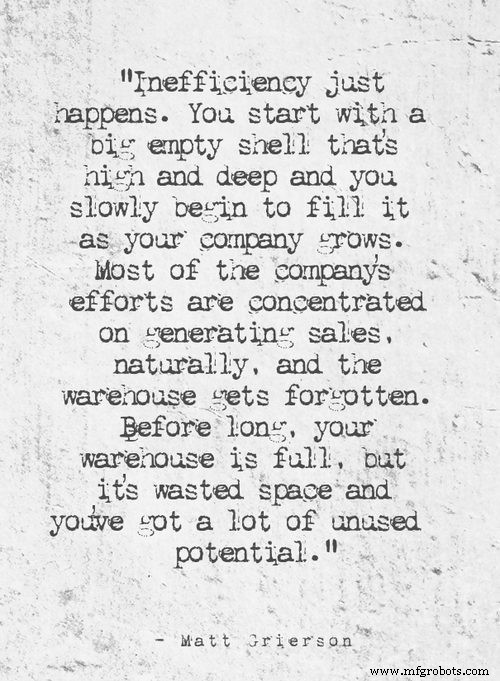
41. Make smart use of floor space. “Matt Grierson is managing director at Dexion, which provides industrial and commercial storage solutions across Europe. He says that only a small fraction of the companies that approach him believing they need to move into larger premises really do need to. The rest have enough space already, they’re just using it badly.
“Grierson says:‘Inefficiency just happens. You start with a big empty shell that’s high and deep and you slowly begin to fill it as your company grows. Most of the company’s efforts are concentrated on generating sales, naturally, and the warehouse gets forgotten. Before long, your warehouse is full, but it’s wasted space and you’ve got a lot of unused potential.’
“By using your space efficiently, your staff can get jobs done quicker and can complete more jobs in a day, you save on purchase or rent by not expanding unnecessarily, and you can go longer before the huge burden of relocating into bigger premises.
“Grierson adds:‘There are a lot of shelving options. Two-tier or mezzanine, fixed or mobile. If you can squeeze your rows of shelving together, and only open them up when access is required, you can save 50% of your floor space.'” – Tim Aldred, How to manage an effective warehouse , The Guardian; Twitter:@tim_aldred
42。 Design storage systems to meet the needs of the current and planned mix of storage types. “The layout of a warehouse that supports an adjoining manufacturing facility will have different requirements than a facility supporting product distribution to stores or a facility that supports end-user fulfillment. Some operations place emphasis on replenishment of product to the point of use, others on product picking or order fulfillment.
“Regardless of the ultimate mission of the warehouse, best-practice companies have designed storage systems to meet the needs of the current and planned mix of storage types. They have optimized storage locations and layouts to fit product without the need to restack or repalletize it once received. The warehouse management system will track storage location profiles and properly assign product to the best storage location. As a result, best-practice companies have excellent cube-fill rates.
“In addition to optimizing the cubic fill of storage locations, best practice is to minimize travel time. If a product is in high demand it should be placed closer to its next point of use. In this case demand should be based on the number times the product is required, not on the number of units required. The difficulty of retrieval should also be considered in travel time. Higher-demand product should be placed on the most easily accessed storage space, typically floor level for racking and between waist and shoulder level in pick racks.” – Kate Vitasek, Storage and Inventory Control Best Practices , Multi-Channel Merchant; Twitter:@mcmerchant
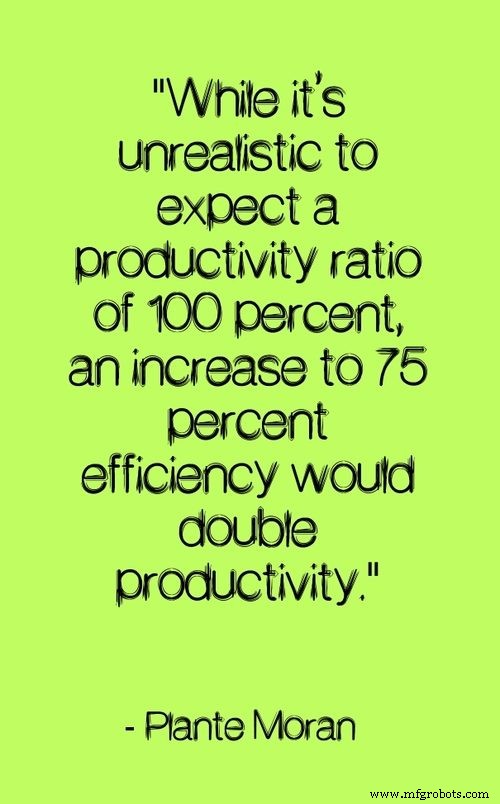
43. Reduce order processing cycle time. “In one analysis of a distribution operation, data revealed that the overall order processing cycle time was extremely inefficient. Of the total order cycle time, it was actually being worked on only 37.9 percent of the time. Six percent of the time was wasted while people dealt with problems such as waiting for lift equipment, computer issues, interruptions, and blocked aisles, and the remaining 56.1 percent of the time orders sat idle. This is a low productivity ratio by any standard. While it’s unrealistic to expect a productivity ratio of 100 percent, an increase to 75 percent efficiency would double productivity. How can this opportunity be captured? ” – Are Your Warehouse Operations Lean? , Plante Moran; Twitter:@PlanteMoran
44。 Implement and maintain operational standards in all functional areas. “Maintain and use standards in all major functional areas. This will assist management in identifying systemic bottlenecks such as aisle congestion or other workflow problems.” – Warehouse Workflow Handbook , WERC; Twitter:@WERC

45. Improve cycle time utilization through lean applications. “Lean applications can help improve cycle time utilization, reduce costs, increase productivity, and increase customer satisfaction. To get to lean, begin with conducting a time study and analysis of the current order fulfillment process. Identify non-value added steps and note the amount of time spent on each of them. Then, assess overall workflow in an attempt to reveal inefficient product pick paths, wasted motion, excessive delays, excessive footsteps, aisle and work area congestion, and equipment availability.” – Chris Calderone, Creating a Lean HME Warehouse Operation , Lean Homecare; Twitter:@LeanHomecare
Best Practices for Improving Inventory Management
46。 Reduce inventory inefficiencies. “Warehouse management systems are critical to tracking the various stages of the manufacturing process. From production to delivery, officials need to be able to monitor inventory as it makes its way through the supply chain. This is especially relevant during periods of growth, as a sudden influx of inventory may overwhelm employees on the floor, leading to costly errors. Without a robust inventory control system, managers may have difficulties locating materials or finished products, causing them to dedicate more manpower and resources to this process. Officials with Land Rover dealt with this issue on a regular basis, according to Zebra Technologies. When vehicles rolled off the assembly line, they were subject to a number of finalization processes, including testing, setting configurations and addressing any existing errors. Managers had a great deal of difficulty identifying where individual items were located along the supply chain, resulting in a high degree of uncertainty and risk.” – Nancy Master, Identifying Warehouse Management Best Practices , RFgen; Twitter:@RFgenSoftware
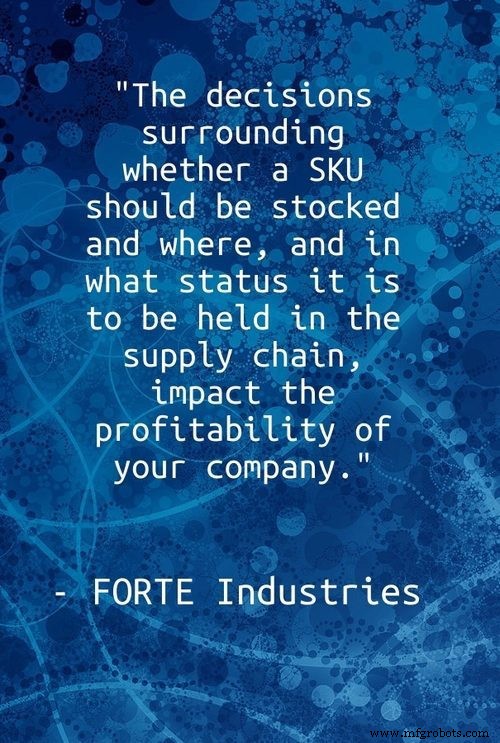
47. SKU profiling can facilitate profitability. “Understanding how every SKU carried in your distribution center (DC) can – and should – contribute to your company’s bottom line – is the best way to design and run DC operations. Here’s why:Each SKU has a potential cost impact that goes well beyond its actual purchase price. The decisions surrounding whether a SKU should be stocked and where, and in what status it is to be held in the supply chain, impact the profitability of your company. And from a selfish standpoint, these same decisions, made without sufficient evaluation, can rob your distribution center of capacity and efficiency.” FORTE Industries
48。 Establish minimum holding stocks to cover lead times. “It has been established that the role of inventory management is to ensure that stock is available to meet the needs of the beneficiaries as and when required.
“Inventory represents a large cost to the humanitarian supply chain. This is made up of the cost of the inventory itself, plus the cost of transporting the goods, cost of managing the goods (labor, fumigation, repackaging, etc) and keeping the goods in warehouses. The inventory manager’s job is to make inventory available at the lowest possible cost.
“In order to achieve this, the inventory manager must ensure a balance between supply and demand by establishing minimum holding stocks to cover lead-times. To achieve this, the inventory manager must constantly liaise with the programs to keep abreast of changing needs and priorities. The warehouse must always have sufficient stocks to cover the lead-time for replacement stocks to avoid stock-outs.” – Warehousing and Inventory Management , Logistics Cluster; Twitter:@logcluster
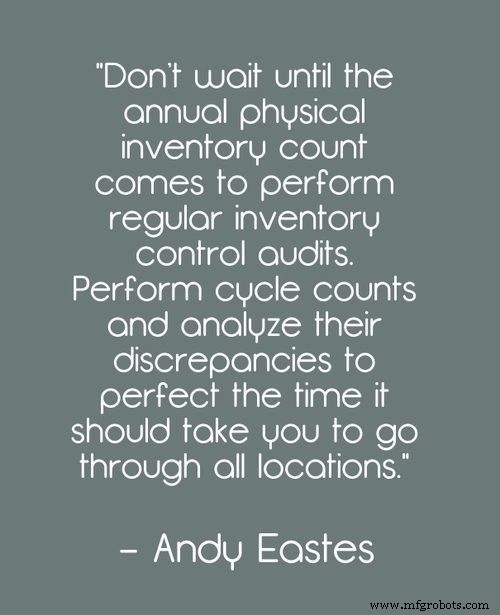
49. Perform cycle counts and analyze discrepancies. “Don’t wait until the annual physical inventory count comes to perform regular inventory control audits. Perform cycle counts and analyze their discrepancies to perfect the time it should take you to go through all locations. It’s good to have cycle counts go through all locations every quarter so that you have a more accurate back-office system.” – Andy Eastes, CEO of Agile Harbor, 10 Ways to improve warehouse efficiency and inventory management without software , SKUVault; Twitter:@skuvault
50。 Develop an approved stock list for each location. “When you stock an item you are making a commitment—a commitment that the product will be available in reasonable quantities for immediate shipment or delivery to customers. Most distributors’ warehouses are filled with two things:‘stock’ and ‘stuff.’ Stock is the material you intend to be in the warehouse. That is, the items necessary to meet or exceed customers’ expectations of product availability. Stuff is everything else. You must separate the stock from the stuff in each of your warehouses. Our goal is to liquidate the stuff and arrange the stock items in such a way to minimize the cost of filling customer orders.” – John Schreibfeder, President of Effective Inventory Management, Inc., The First Step to Achieving Effective Inventory Control , via Lanham Associates; Twitter:@LanhamAssoc
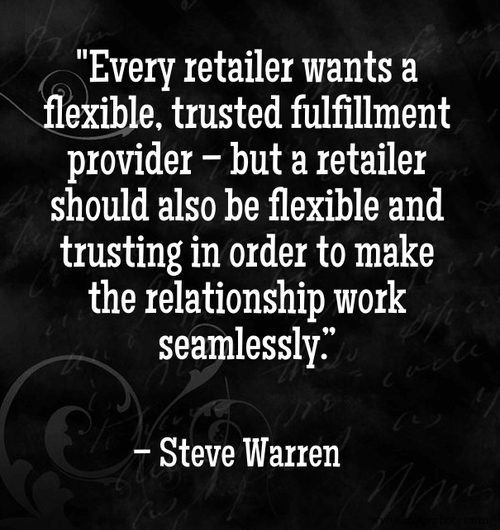
51. Maintain constant, consistent communication with vendors. “A good relationship with your vendors is crucial to your company’s success – especially if you outsource any part of your retail operations. Your fulfillment provider becomes your brand in the eyes of the customer, so it’s important that they understand your plans for your inventory as well as you do.
“This means constant communication of your promotional plans, product information, and upcoming releases. Every retailer wants a flexible, trusted fulfillment provider – but a retailer should also be flexible and trusting in order to make the relationship work seamlessly.” – Steve Warren, 4 Tips for Effective Inventory Management , Multi-Channel Merchant; Twitter:@mcmerchant
52. Achieve inventory analysis efficiency. “With solid inventory analysis, you can ensure that you are investing in the right amount of the right products to remain competitive. By developing and using a comprehensive set of tools to closely monitor the performance of your inventory, you can achieve more of your goals more efficiently.” – Bill Knapp, Socius, Beyond Software:6 Effective Inventory Management Practices , featured on the ERP Software Blog; Twitter:@erpsoftwareblog and @mssocius
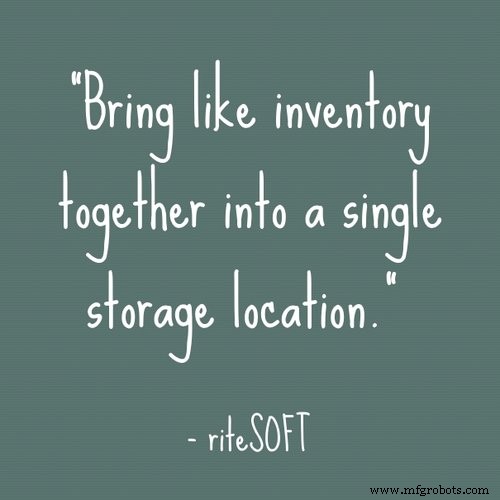
53. Understand the warning signals. “The easiest way to identify that you have too much—or the wrong inventory—is the amount of dust settled on the product in storage. If you see more than ½ inch of dust, then that’s likely a sign of obsolete inventory. However, there are other, more specific indicators that inventory management issues need to be addressed.
“If there are significant discrepancies between the book inventory and physical inventory, this is a direct indicator that there is a problem with inventory management. Another distinct indicator is when your warehouse staff is having trouble locating inventory on a timely basis—an issue that’s particularly critical when FIFO, batch/lot number or serial number controls are involved.
“The issue of locating specific inventory is typically tied to inventory discrepancies. And, of course, if you’ve seen a trend in the increased use of outside storage space, then this can indicate another ongoing inventory management issue.” – Norm Saenz and Don Derewecki of St. Onge, Inventory Management 101:Time to revisit the principles , Logistics Management; Twitter:@LogisticsMgmt
54. Use both fixed and moveable tracking options. “When companies think of warehouse tracking, they think primarily of movable tracking options, tracking the units and pallets that actually get moved around the warehouse and sent up the supply chain. This is only one part of the warehouse management process – do not forget the benefits that come with used fixed trackers, too! By tracking fixed warehouse assets, you are able to assign and manage destinations much more easily, and arrange strategy protocols as needed without mass confusion. It is better to think of warehouse tracking in two different parts, one fixed and one movable.” – Justin Velthoen, 7 Tips for Warehouse Inventory Management , QStock Inventory; Twitter:@QStockInventory

55. For physical count inventory, keep like inventory together in a single location. “Bring like inventory together into a single storage location. The same part shouldn’t be in several storage areas unless physical size dictates a limitation. In that case, keep available quantities to a minimum and move remainder to a location that isn’t part of the easily accessible storage (overstock location).” – Warehouse Management Tips for Physical Count Inventory , riteSOFT; Twitter:@ritesoft
Camcodeのアセットトラッキングソリューション:
- 在庫管理
- 在庫管理
- カスタムフォイルラベル
- 倉庫の看板
- 通路の標識
- ステンレス鋼タグ
- フロアラベル
- セキュリティラベル
- 磁気ラベル
- アセットタグ
産業技術
- CMMSが倉庫管理をどのように改善できるか
- 油圧のベストプラクティスとメンテナンスのヒント
- ベスト 25 の倉庫最適化ソフトウェア ツール
- 倉庫在庫追跡の6つのベストプラクティス
- IT資産管理の50のベストプラクティス
- 倉庫の生産性:15人の専門家が、より効率的で生産的な倉庫運用のためのヒントを明らかにします
- 倉庫在庫管理の究極のガイド:在庫管理フレームワーク、ベストプラクティス、ソフトウェア、モビリティ、およびローテク在庫ソリューションに関する80の信頼できるリソース
- 最高の倉庫管理プレゼンテーションとスライドデッキ:倉庫業務の合理化、生産性の向上などに関する50の詳細なリソース
- トップ倉庫管理トレーニングリソース:倉庫管理の実践をマスターするための50のコース、ウェビナー、チュートリアルなど
- 倉庫管理ソフトウェア:倉庫の効率を改善し、諸経費を削減し、利益を増やすための52の最高のツールとシステム
- 倉庫ラッキングのヒントと戦術:生産性を最大化するための50の専門家による倉庫ラッキングのアイデア、戦略、システム



